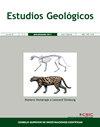Nota sobre la taxonomía de Microtus (Iberomys) (Arvicolinae, Rodentia) del Pleistoceno superior de la Gruta do Caldeirão (Tomar, Portugal) e interpretación paleoclimática de la asociación de roedores
IF 0.8
4区 地球科学
Q3 GEOLOGY
引用次数: 3
Abstract
Gruta do Caldeirao is an archaeological cave site located in Tomar (Portugal, western Iberian Peninsula), which contains an important Late Pleistocene sequence from Middle Paleolithic (Mousterian) to Upper Paleolithic (Solutrean-Magdalenian), including lithic tools, human remains, and other large- and small-vertebrate remains. Our revision and interpretation of the rodent assemblage previously published in the 1990s leads to three important conclusions: 1) the only species of the subgenus Iberomys present in the sequence is the current endemic Iberian vole species Microtus (Iberomys) cabrerae (Cabrera’s vole); 2) the rodent assemblage is dominated throughout by open-forest species, such as the long-tailed field mouse ( Apodemus sylvaticus ), and species associated with open-humid areas such as the Mediterranean and Lusitanian pine voles ( Microtus (Terricola ) spp.), with the notable presence of an extinct hamster ( Allocricetus bursae ) in layer K, and three vole species not currently found in the vicinity of the cave ( Microtus arvalis [the common vole], M. Agrestis [the field vole], and Chionomys nivalis [the European snow vole]) also in the assemblage; 3) the bioclimatic model, which is used to reconstruct climatic parameters on the basis of the rodent association, corroborates the proposal that the Solutrean occupation from layers H to Fa took place during a cold period equated to the Last Glacial Maximum (LGM), as indicated by the available radiocarbon dates and supported by the magnetic susceptibility data.关于Gruta do caldeirao (Tomar, Portugal)晚更新世Microtus (Iberomys) (Arvicolinae, Rodentia)的分类和啮齿动物协会的古气候解释的说明
Gruta do Caldeirao是位于托马尔(葡萄牙,伊比利亚半岛西部)的一个考古洞穴遗址,其中包含了一个重要的晚更新世序列,从旧石器时代中期(莫斯特期)到旧石器时代晚期(梭鲁特-马格达莱尼期),包括石器工具、人类遗骸和其他大型和小型脊椎动物遗骸。我们对20世纪90年代发表的啮齿动物组合进行了修订和解释,得出了三个重要结论:1)序列中唯一存在的伊比利亚亚属物种是目前特有的伊比利亚田鼠种Microtus (Iberomys) cabrerae (Cabrera’s volae);2)整个啮齿动物群落以开放森林物种为主,如长尾田鼠(Apodemus sylvaticus),以及与开放潮湿地区有关的物种,如地中海和卢西塔尼松田鼠(Microtus (Terricola) spp.),在K层中有一种已灭绝的仓鼠(Allocricetus bursae),以及目前在洞穴附近未发现的三种田鼠(Microtus arvalis[普通田鼠],M. Agrestis[田鼠],和Chionomys nivalis[欧洲雪田鼠])也在组合中;3)利用生物气候模型重建了基于啮齿动物关联的气候参数,证实了从H层到Fa层的溶蚀期发生在末次盛冰期(Last Glacial Maximum, LGM)的寒冷时期,这一观点得到了放射性碳测年和磁化率数据的支持。
本文章由计算机程序翻译,如有差异,请以英文原文为准。
求助全文
约1分钟内获得全文
求助全文
来源期刊

Estudios Geologicos-Madrid
GEOLOGY-
CiteScore
1.40
自引率
14.30%
发文量
6
审稿时长
>12 weeks
期刊介绍:
Since 1945 Estudios Geologicos publishes original research works, as well as reviews, about any topic on Earth Sciences.
Estudios Geologicos is published as one yearly volume, divided into two half-yearly issues. It is edited by the Spanish National Research Council (Consejo Superior de Investigaciones Científicas, CSIC) at the Instituto de Geociencias (CSIC-UCM).
Estudios Geologicos provides free access to full-text articles through this electronic edition. Accepted articles appear online as "Forthcoming articles" as soon as the galley proofs have been approved by the authors and the Editor-in-Chief. No changes can be made after online publication.
 求助内容:
求助内容: 应助结果提醒方式:
应助结果提醒方式:


